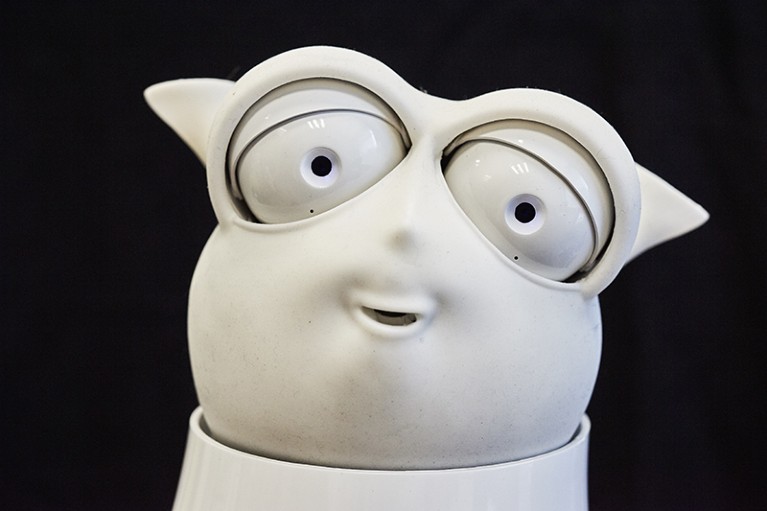
‘Empathy robot’ Reeti, made in France for use in health care. In a new book, Eric Topol wants to see medics themselves freed to provide compassion to patients.Credit: BSIP/UIG via Getty
Deep Medicine: How Artificial Intelligence Can Make Healthcare Human Again Eric Topol Basic (2019)
So much has been written about artificial intelligence (AI) that any new book on it can struggle to create a signal amid the noise. There are volumes hyping AI as the fourth industrial revolution, others decrying it as the greatest threat to modern society and many calling for AI to become less artificial and more intelligent.
Now, Eric Topol, a cardiologist and director of the Scripps Research Translational Institute in La Jolla, California, adds his voice. Deep Medicine summarizes hype and threat, then takes us to a place where no one else has gone: a future in which AI helps to re-establish empathy and trust between doctors and patients.
Topol’s thesis, expressed in the subtitle, is that AI “can make healthcare human again”. The task is formidable because AI, which has transformed how we seek information, how we shop, how we connect to each other, has had comparatively little impact on health care. The effects thus far — electronic medical records, data collection for billing and the development of high-tech procedures such as robotic surgery — seem to have made health care decidedly less human. Can AI reverse this trend and heal the doctor–patient relationship? Or will it exacerbate the problems of technology, but with devices that replace more humans and destroy privacy? Topol takes an optimistic view.
Deep Medicine provides a broad survey of how AI is applied in medicine. The obvious applications build on what algorithms do best: pattern recognition. We learn how AI is being applied in radiology to read X-ray films, in pathology to identify tumour cells and in dermatology to diagnose skin lesions. Topol describes a similar approach in ophthalmology, where algorithms can detect diabetic retinopathy, and in cardiology, where AI is beginning to uncover cardiac arrhythmias such as atrial fibrillation by tracking data from wrist-based sensors.
More unusual is AI’s deployment in mental health care, through robots that can read mood from shifts in voice and facial expressions, an approach pioneered by the new field of affective computing. And Topol sees as inevitable algorithms that can integrate data from online behaviour (such as patterns of typing or scrolling), sensors, the medical literature and clinical records. His argument is that AI will inherit the tasks best done by machines, leaving humans time to do what they do best — providing compassion and being “present” for patients.
But this survey, for all its promise, is still mostly a promise. As Topol admits, there are few controlled trials in this field. Most of the research is at the stage of algorithm validation by technology companies, and we still lack examples of AI improving outcomes in the real world of clinical practice.
We are in the first act of what will probably be a five-act play. The characters are clear: technology giants Google, Baidu, Alibaba, Apple, Amazon, IBM and Microsoft, along with hundreds of health-tech start-ups in the United States and Europe — including my own — and more than 130 medical AI companies in China. The problem is evident: health care has become a massively expensive enterprise that no longer serves the needs of doctors and patients. In wealthy countries, the costs continue to grow without commensurate improvements in outcomes. In poorer regions, the lack of health-care workers becomes unsustainable as the population and its needs expand. And the setting for this play is appealing: a sea of data from online behaviour, sensors, smartphones, genome scans, imaging, lab tests and clinical records. If data are the new oil, health data — which Topol describes as between six and ten times as valuable as financial data — are the refined petroleum that AI can inject into diagnostic and treatment decisions.
But big data is not the same as good data. For most health-care questions, we might not have the information to find a solution. For instance, we recognize the role of social determinants in health but rarely collect data on them. And even if the data were optimal, the algorithms accurate and the diagnostic process improved, would doctors choose to be present? Would they be educated to be empathetic and compassionate? Deep Medicine wrestles with these questions, recognizing that technology is about tools, whereas medicine is about a person-to-person bond.
This is Topol’s third popular-science book. The first, The Creative Destruction of Medicine (2011), focused on sensors and sequencing as a pathway for digitizing medicine. The second, The Patient Will See You Now (2014), described how practice could be transformed by empowering people with their own health data. Like these, Deep Medicine is about technology and health care, but it evolves surprisingly towards the values of the past while imagining the tools of the future. When Topol describes how medicine has changed since his training four decades ago, one feels his regret that technology has not improved things. He addresses that by bringing together the deep phenotyping of digitized medicine, the engagement of the empowered patient and the analytical power of AI to improve the doctor–patient relationship.
I appreciate Topol’s willingness to recognize that these are early days. He invites us to dream about what the AI future could look like, while reminding us that we need to be drivers, not just passengers, if AI is to serve patients and clinicians rather than payers and tech monopolies. Much of what he has written will soon be outdated in this fast-moving field, but his argument for using technology to bring care back to health care is timeless.

 Blood, sweat and tears in biotech — the Theranos story
Blood, sweat and tears in biotech — the Theranos story
 Public health: Gore and glory
Public health: Gore and glory
 Ageing more gracefully
Ageing more gracefully






